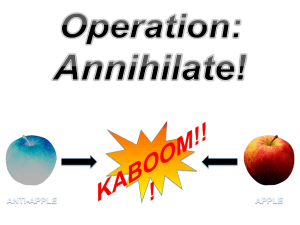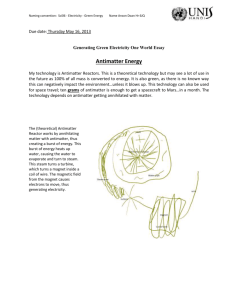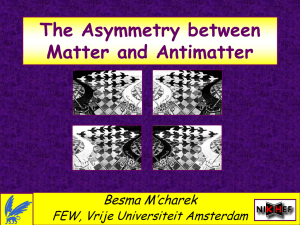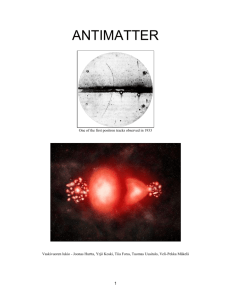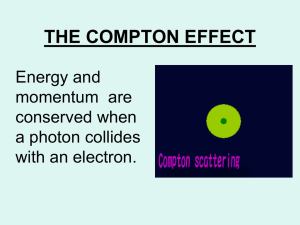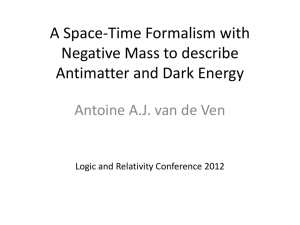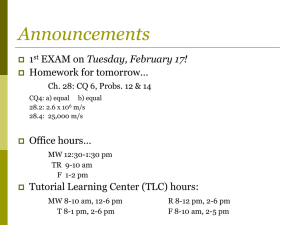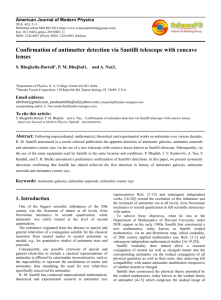Knowing Anti-Me, Knowing Anti-You - Education
advertisement
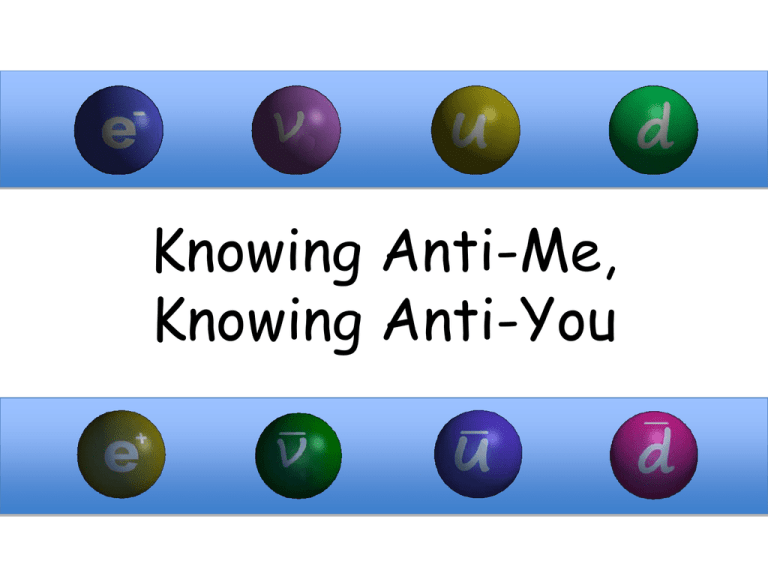
Knowing Anti-Me, Knowing Anti-You (Teachers may wish to elicit such questions regarding their own students’ pre-conceptions about antimatter before embarking on this introductory lesson plan) “Antimatter?—that’s extremely combustible stuff, isn’t it? ‘Angels & Demons’ and ‘Star Trek’ told me so.” “What about warp-drive for starships— they use matter-antimatter reactors, don’t they?” “I read that it could be the fuel source of the future.” “OK then. Tell us— what IS antimatter?” “…and where can I get some?” From the film “Angels & Demons” (2009)* To see the video, click on the picture : *In the lesson “Operation: Annihilate”, we look at this clip in greater detail. Here it is meant simply as an appetizer. Antimatter has been around in popular culture long before the release of the film “Angels & Demons” (or the 2000 Dan Brown novel on which the film is based). The following are some examples from the television series “Star Trek”: From Star Trek (The Original Series) Season 3 episode “That Which Survives” (1969) Spock: Scotty: Spock: Scotty: Spock: Scotty: Spock: Scotty: Spock: As I recall the pattern of our fuel flow, there is an access tube leading to the matter-antimatter reaction chamber. Aye, there’s a service crawlway, but it’s not meant to be used while the integrator operates. Still, it is there and it may be possible to shut off the flow of fuel at that point. What with? Bare hands? A magnetic probe. Any matter that comes in contact with antimatter triggers the explosion. And I’m not even sure a man can live in a crawlway in the energy stream of the magnetic field that bottles up the antimatter! I shall try. You’ll be killed man! Unless a solution is found quickly, that fate awaits all of us. Star Trek © Paramount Pictures From Star Trek (The Original Series) Season 1 episode “The Alternative Factor” (1967) Kirk: I don’t follow you. Spock: Two parallel universes—project this—one positive the other negative. Or more specifically, one matter, the other antimatter. Kirk: Do you know what you’re saying? Matter and antimatter have a tendency to cancel each other out—violently. Spock: Precisely. Under certain conditions— when two identical particles of matter and antimatter meet. Annihilation, Jim. Total, complete, absolute annihilation. Star Trek © Paramount Pictures From Star Trek (The Next Generation) Season 1 episode “Coming of Age” (1988) Computer Voice: Last question on the hyperspace physics test: “If the matter and antimatter tanks on a galaxy class starship are nine-tenths depleted, calculate the intermix ratio necessary to reach a star-base 100 light years away at warp factor 8”. Begin. Star Trek © Paramount Pictures Well, that’s what film and television have been telling us about antimatter. But what is the reality? Just FOUR particles make up all of the visible matter in the Universe*… *For a short tutorial on fundamental particles, see “What Are The Indivisibles?” in the Background Materials: Just FOUR particles make up all of the visible matter in the Universe*… electron neutrino up quark *For a short tutorial on fundamental particles, see “What Are The Indivisibles?” in the Background Materials: down quark But, the Universe does have other particles up its sleeve. For one thing, each of the matter particles has a twin. No, not an evil twin… electron neutrino up quark down quark …an ANTIMATTER twin. electron neutrino up quark down quark positron anti-neutrino anti-up quark anti-down quark It is traditional to use a little bar in the symbol for an antimatter particle to distinguish it from the symbol for its matter twin (the exception is the positron, where we use a ‘+’ instead of the ‘-’ of the electron). Antimatter is not the stuff of science fiction. It exists. It is the stuff (or rather, the anti-stuff) of science fact. electron neutrino up quark down quark positron anti-neutrino anti-up quark anti-down quark It is traditional to use a little bar in the symbol for an antimatter particle to distinguish it from the symbol for its matter twin (the exception is the positron, where we use a ‘+’ instead of the ‘-’ of the electron). Matter, Antimatter: What’s the difference? Matter, Antimatter: What’s the difference? There is one essential and obvious difference: −1 +1 Matter, Antimatter: What’s the difference? There is one essential and obvious difference: A particle of matter that has an ELECTRIC CHARGE has an antiparticle twin with the exact opposite charge. If you require information on electric charge as it pertains to this lesson, see “Will You Be Charging That?” in the Background Materials: −1 +1 Matter, Antimatter: What’s the difference? There is one essential and obvious difference: A particle of matter that has an ELECTRIC CHARGE has an antiparticle twin with the exact opposite charge. For example, if the electron has a charge of -1, −1 +1 Matter, Antimatter: What’s the difference? There is one essential and obvious difference: A particle of matter that has an ELECTRIC CHARGE has an antiparticle twin with the exact opposite charge. For example, if the electron has a charge of -1, Electron Charge: -1 −1 +1 Matter, Antimatter: What’s the difference? There is one essential and obvious difference: A particle of matter that has an ELECTRIC CHARGE has an antiparticle twin with the exact opposite charge. For example, if the electron has a charge of -1, then its antiparticle, the positron, has a charge of +1. Electron Charge: -1 −1 +1 Matter, Antimatter: What’s the difference? There is one essential and obvious difference: A particle of matter that has an ELECTRIC CHARGE has an antiparticle twin with the exact opposite charge. For example, if the electron has a charge of -1, then its antiparticle, the positron, has a charge of +1. Electron Charge: -1 −1 Positron Charge: +1 +1 Remember that protons and neutrons are made up of particular combinations of the up and down quarks, and that these quarks have a fractional charge… PROTON (p) Composed of: 2 up quarks and 1 down quark +⅔ +⅔ -⅓ Total charge: ⅔ + ⅔ − ⅓ = +1 NEUTRON (n) Composed of: 1 up quark and 2 down quarks -⅓ +⅔ -⅓ Total charge: ⅔−⅓−⅓ = 0 Likewise, particular combinations of the anti-up and anti-down quarks make up antiprotons and antineutrons. Again, the anti-up and anti-down quarks have the opposite charge of their matter twins… ANTIPROTON (p): Composed of: 2 anti-up quarks and 1 anti-down quark -⅔ -⅔ +⅓ Total charge: -⅔ − ⅔ + ⅓ = −1 ANTINEUTRON (n): Composed of: 1 anti-up quark and 2 anti-down quarks +⅓ -⅔ +⅓ Total charge: -⅔ + ⅓ + ⅓ = 0 Notice that the antineutron also has zero charge. If a particle has no charge, then its antiparticle has no charge. In a magnetic field, a particle with an electric charge will be deflected by the same amount as its antiparticle BUT in opposite directions: For example…. Direction of magnetic field S N Deflection of an ELECTRON in a magnetic field Direction of magnetic field S N Deflection of a POSITRON in a magnetic field How are Matter and Antimatter similar? How are Matter and Antimatter similar? As far as we can tell, particles and antiparticles have IDENTICAL masses. (The fact that a particle and its antiparticle are deflected by the same amount in a magnetic field, is an indication to us that the mass of a particle and its antiparticle are identical). For example… proton mass = antiproton mass We also BELIEVE, though it has yet to be PROVED experimentally, that antimatter behaves IDENTICALLY to matter under the influence of GRAVITY. Antimatter Matter For example, if you were able to drop a certain amount of matter and antimatter in a gravitational field, we believe that they would accelerate at precisely the same rate. Antimatter Matter For example, if you were able to drop a certain amount of matter and antimatter in a gravitational field, we believe that they would accelerate at precisely the same rate. For example, if you were able to drop a certain amount of matter and antimatter in a gravitational field, we believe that they would accelerate at precisely the same rate. Matter Antimatter In addition to the fundamental antiparticles, entire anti-atoms are possible. In fact, human beings have already made one: In addition to the fundamental antiparticles, entire anti-atoms are possible. In fact, human beings have already made one: ANTIHYDROGEN Good old HYDROGEN. It’s the simplest atom we know. It consists of 1 proton and 1 electron. Let us picture a hydrogen atom as an electron orbiting its nucleus, a proton. Let us picture a hydrogen atom as an electron orbiting its nucleus, a proton. Hydrogen (H) Let us picture a hydrogen atom as an electron orbiting its nucleus, a proton. BUT REMEMBER— this is NOT an accurate depiction! (For one thing, in the proper scale, our electron would have to be drawn about 1 kilometer away from the proton). Hydrogen (H) Let us picture a hydrogen atom as an electron orbiting its nucleus, a proton. BUT REMEMBER— this is NOT an accurate depiction! (For one thing, in the proper scale, our electron would have to be drawn about 1 kilometer away from the proton). Hydrogen (H) Let us now picture an antihydrogen atom as a positron orbiting its nucleus, an antiproton. (The same warnings apply!) Let us picture a hydrogen atom as an electron orbiting its nucleus, a proton. BUT REMEMBER— this is NOT an accurate depiction! (For one thing, in the proper scale, our electron would have to be drawn about 1 kilometer away from the proton). Hydrogen (H) Let us now picture an antihydrogen atom as a positron orbiting its nucleus, an antiproton. (The same warnings apply!) AntiHydrogen (H) - At CERN in 1995, The very first atoms of ANTIHYDROGEN were made. From an initial production in 1995 of just a few atoms in 3 weeks, a few million have been produced on a worldwide basis in the intervening years.* Although that may seem impressive, remember that it takes about 600,000,000,000,000,000,000,000 antihydrogen atoms to make just one gram. * See the following links to find out more: http://press.web.cern.ch/press/PressReleases/Releases1996/PR01.96EAntiHydrogen.html Antihydrogen Atoms Made At Cern http://cool-antihydrogen.web.cern.ch/cool-antihydrogen/ How far can we go with this? Could we have other anti-atoms? How about anticarbon, antinitrogen, antioxygen? How far can we go with this? Could we have other anti-atoms? How about anticarbon, antinitrogen, antioxygen? What about an entire Periodic Anti-Table? How far can we go with this? Could we have other anti-atoms? How about anticarbon, antinitrogen, antioxygen? What about an entire Periodic Anti-Table? How far can we go with this? Could we have other anti-atoms? How about anticarbon, antinitrogen, antioxygen? What about an entire Periodic Anti-Table? How far can we go with this? Could we have other anti-atoms? How about anticarbon, antinitrogen, antioxygen? What about an entire Periodic Anti-Table? THEORETICALLY SPEAKING, COMBINATIONS OF POSITRONS, ANTIPROTONS AND ANTINEUTRONS COULD GENERATE ANTI-VERSIONS OF ALL OF THE ELEMENTS IN THE PERIODIC TABLE. Though it may annoy your chemistry teacher, chemistry is basically the study of what happens when bunches of atoms come together. Though it may annoy your chemistry teacher, chemistry is basically the study of what happens when bunches of atoms come together. As two hydrogen atoms approach each other, their nuclei repel (why?). This repulsion is overcome because the electron in one atom attracts the proton in the other atom. Though it may annoy your chemistry teacher, chemistry is basically the study of what happens when bunches of atoms come together. As two hydrogen atoms approach each other, their nuclei repel (why?). This repulsion is overcome because the electron in one atom attracts the proton in the other atom. The best configuration is when the atoms are bound together. We then have a hydrogen molecule. AS AN EXERCISE, REPLAY THE FORMATION OF A HYDROGEN MOLECULE, ONLY THIS TIME USING ANTIHYDROGEN ATOMS. WOULD THERE BE ANY DIFFERENCE FROM THE POINT OF VIEW OF THE FORCES OF ATTRACTION AND REPULSION? WOULD AN ANTIHYDROGEN MOLECULE BE FORMED? AS AN EXERCISE, REPLAY THE FORMATION OF A HYDROGEN MOLECULE, ONLY THIS TIME USING ANTIHYDROGEN ATOMS. WOULD THERE BE ANY DIFFERENCE FROM THE POINT OF VIEW OF THE FORCES OF ATTRACTION AND REPULSION? WOULD AN ANTIHYDROGEN MOLECULE BE FORMED? (With respect to forces of attraction and repulsion, there is a complete symmetry between these two cases. Thus, an antihydrogen molecule WOULD be formed) Can we keep going? Can we keep going? If anti-hydrogen molecules are a theoretical possibility, AND the chemistry of antimatter is identical to that of matter… Can we keep going? If anti-hydrogen molecules are a theoretical possibility, AND the chemistry of antimatter is identical to that of matter… Then how about bigger AND BIGGER anti-molecules? Can we keep going? If anti-hydrogen molecules are a theoretical possibility, AND the chemistry of antimatter is identical to that of matter… Then how about bigger AND BIGGER anti-molecules? AS A LITTLE THOUGHT EXPERIMENT, TAKE THIS LINE OF THINKING AS FAR AS YOU CAN… WHAT DO YOU COME UP WITH? And what about an Anti-You? What would your Anti-You look like? And what about an Anti-You? What would your Anti-You look like? If we took You And what about an Anti-You? What would your Anti-You look like? If we took You Insert your photo here And what about an Anti-You? What would your Anti-You look like? If we took You Insert your photo here and reversed the charges of all of the particles that make you up (in other words change your electrons to positrons, your protons to antiprotons, and your neutrons to antineutrons), the resulting forces would be the same. And what about an Anti-You? What would your Anti-You look like? If we took You Insert your photo here and reversed the charges of all of the particles that make you up (in other words change your electrons to positrons, your protons to antiprotons, and your neutrons to antineutrons), the resulting forces would be the same. These forces have given you your structure—and so, your appearance. So, Anti-You would look exactly like You. Insert your photo here AGAIN So, Anti-You would look exactly like You. Insert your photo here AGAIN However, if You and your Anti-You were to meet… So, Anti-You would look exactly like You. Insert your photo here AGAIN However, if You and your Anti-You were to meet… To gain an understanding into what would happen in such an encounter, go to the lesson “Operation: Annihilate!”. One Final Note: You will sometimes see an anti-object depicted as a mirror-image photo-negative of the original object. For example: BANANA ANTI-BANANA In the Extension Lesson “Through The Looking Glass”, we discuss why antimatter can be thought of as a negative mirror-image of matter. But it should be understood that bulk antimatter would look identical to bulk matter. A depiction like the one above is simply used for effect!
